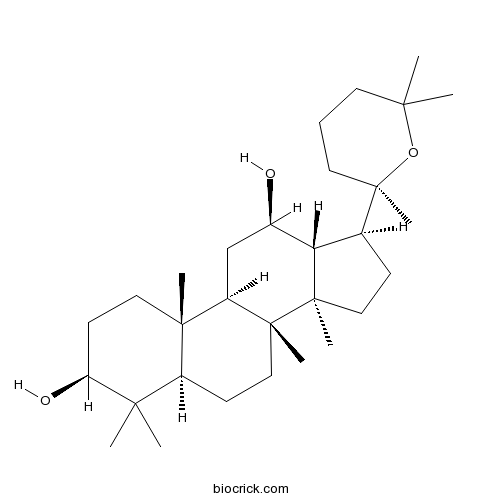| Catalog No. | BCN1080 |  |
|
| CAS RN | 19666-76-3 | ||
| Molecular Weight | 460.73 | ||
| Molecular Formula | C30H52O3 | ||
| Database | [PubChem]:382157905 [ChEBI]: [PCIDB]: |
||
InChI=1S/C30H52O3/c1-25(2)13-9-14-30(8,33-25)19-10-16-29(7)24(19)20(31)18-22-27(5)15-12-23(32)26(3,4)21(27)11-17-28(22,29)6/h19-24,31-32H,9-18H2,1-8H3/t19-,20+,21-,22+,23-,24-,27-,28+,29+,30+/m0/s1
Panaxadiol , a ginseng saponin with a dammarane skeleton, selectively interferes with the cell cycle in human cancer cell lines, it inhibits DNA synthesis in a dose-dependent manner with IC50 values ranging from 0.8 to 1.2 µM in SK-HEP-1 cells and HeLa cells, it selectively elevates p21WAF1/CIP1 levels and thereby arrests the cell cycle at G1/S phase by down-regulating Cyclin A–Cdk2 activity.[1]
Panaxadiol, a purified ginseng component, can enhance the anti-cancer effects of 5-fluorouracil in human colorectal cancer cells.[2]
Panaxadiol fraction and its ginsenosides can induce the antioxidant enzymes which are important for maintaining cell viability by lowering the level of oxygen radical generated from intracellular metabolism.[3]
Pretreatment with ginseng total saponin, especially panaxatriol, ameliorates I/R-induced myocardial damage and this protection is caused by reducing oxidative stress.[4]
English website: Panaxadiol
Japanese website: Panaxadiol
Chinese website: Panaxadiol
[1] Ying H J, Choi J S, Shin S, et al. Carcinogenesis, 2003, 24(11):1767-72.
[2] Li X L, Wang C Z, Mehendale S R, et al. Cancer Chemoth Pharm, 2009, 64(6):1097-104.
[3] Chang M S, Lee S G, Rho H M. Phytother Res, 1999, 13(8):641-4.
[4] Kim T H, Lee S M. Food Chem Toxicol , 2010, 48(6):1516-20.
[5] Shi L L, Qin W M, Zhu Z J, et al. Physical Testing & Chemical Analysis, 2010, 46(5):482-4.


